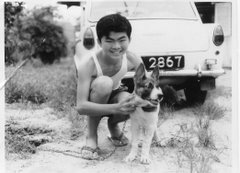When we arrived in Singapore in 1961, one
of the first things my father bought was a Sony Transistor Radio. It was a very modern-looking device, not like
the big brown wireless sets that we were used to back home. The picture, I think, shows the exact
model.
As I remember, there was, essentially, only
one English language station, transmitted by Radio Singapura. There were all sorts of programmes, including
news, comedy drama, music of all sorts, and current affairs. Unlike the BBC, Radio Singapura carried
adverts. We quickly got to learn the
jingles for Tiger Oil and Brand’s Essence of Chicken. The Tiger advert went something like this:
Tiger
Oil. Tiger Oil.
For
fast relief of colds aches and pains.
It is
used throughout the world.
You
must get some right away.
Tiger
Oil makes your day a happy day.
As well as the adverts there was constant
political propaganda and patriotic songs.
At the time that Malaysia was being formed, we were treated to Malaysia Forever every hour or so.
Let’s
get together.
Sing
a happy song.
Malaysia
Forever.
Ten
Million strong.
That soon changed when Singapore left
Malaysia.
My favourite radio programs were a comedy
whose name I can’t remember, and an American real-life detective series called The Mistakes They Made.
Also available – but only just – was the
BBC World Service. It was very faint,
and would be accompanied by eerie electronic whistles and other sci-fi sounds,
and it would fade in and out, but we liked to tune in for cricket matches and
the English Football results. It was
quite frustrating, as just as our team’s result came on the radio would fade
out or whistle, so we would only hear half the score. Nevertheless, it was a Saturday night ritual,
long after lights out, to listen to the results. Given the time difference, it would be
midnight when the results were read out.
One evening, in February 1963, we were
driving home from somewhere. An enormous
crowd of people was gathered outside a shop window. They were watching Singapore’s first
television broadcast. This was the first
time Singaporeans had seen a television, and it must have been a magical
experience for them. Of course, it was
in black and white, but nobody minded.
Everyone wanted a TV, although they were very expensive in the early
days, and for the first few years we did our viewing at the Island Club, at
friends’ houses, or in restaurants (where a TV was a big added attraction).
For most of the 1960s, as I remember, there
was only one channel, and it catered for at least four language groups – Malay,
Chinese, Tamil and English. I know that
there was more than one Chinese language in use, but I don’t know if TV
Singapura catered for them all. Such was
the addiction of TV that sometimes we would watch the programmes even when they
were in a language that we didn’t understand. Indian and Chinese cinema was
very dramatic, and sometimes you could follow the story without knowing the
language. Of course, my favourite
programmes were the American comedies (like I
Love Lucy), adventure programmes and cartoons.
Eventually we bought a TV and had the
pleasure of constantly trying to get a decent picture by adjusting the angle of
the ariel, and playing with the vertical hold because the picture kept going
round and round.
How things have changed.
Related posts












 Photo of me (in singlet), my parents and my younger brother in front of our first TV set
Photo of me (in singlet), my parents and my younger brother in front of our first TV set


 Photo of Hiroshima Peace Crane courtesy of
Photo of Hiroshima Peace Crane courtesy of 




